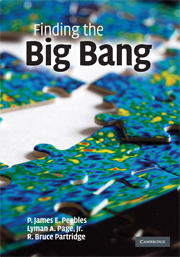3 - Origins of the cosmology of the 1960s
Published online by Cambridge University Press: 05 July 2015
Summary
To understand the essays in the next chapter about what happened in the 1960s you have to appreciate the nature of research in cosmology then. To understand the nature of this research you have to consider its history. Figure 3.1 illustrates the major steps leading to one big advance in cosmology, the identification of the CMBR as a fossil remnant from the big bang. This figure was made by members of Princeton Gravity Research Group. David Wilkinson was its main author, he used it in lectures on cosmology starting in 1968, and it is a good illustration of his style. Another version was eventually published (in Wilkinson and Peebles 1983).
The figure maps relations among the topics we discuss in this chapter. The map is complicated because the story is complicated, but there are a few themes. We begin with the first of these, the development of the idea that the abundances of the stable isotopes of the lightest elements, hydrogen and helium, were determined by thermonuclear reactions in the early hot stages of expansion of the universe (with modest adjustments for what happened in stars much later). We consider next the line of thought that led Dicke to persuade Roll and Wilkinson to search for the CMBR. We then turn to the development of the means of detecting and measuring the properties of the radiation left from the hot big bang. We conclude this chapter with an assessment of what people were thinking and doing in cosmology in the early 1960s, at the start of the time surveyed by the essays in the next chapter.
Nucleosynthesis in a hot big bang
Hydrogen is the most abundant of the chemical elements (apart from places like Earth where the heavier elements have collected and condensed), helium amounts to about 25% by mass, and only about 2% of the baryon mass is in heavier elements.
- Type
- Chapter
- Information
- Finding the Big Bang , pp. 23 - 68Publisher: Cambridge University PressPrint publication year: 2009



